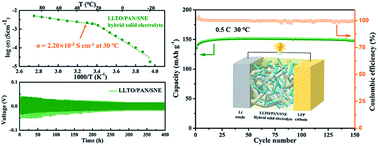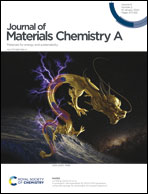A hybrid solid electrolyte Li0.33La0.557TiO3/poly(acylonitrile) membrane infiltrated with a succinonitrile-based electrolyte for solid state lithium-ion batteries†
Abstract
Solid state lithium-ion batteries are considered as one of the most promising next-generation technologies for energy storage. However, the low ionic conductivity of solid electrolytes and interfacial compatibility issues remain huge challenges to solid state lithium-ion batteries. Herein, a novel hybrid solid electrolyte (HSE) membrane consisting of Li0.33La0.557TiO3 (LLTO) ceramic nanorods, poly(acylonitrile) (PAN) and succinonitrile (SN) is constructed. The HSE integrates their merits and shows a high ionic conductivity of 2.20 × 10−3 S cm−1 at 30 °C. It also exhibits a high electrochemical window of 5.1 V (vs. Li/Li+), superior thermal stability and good mechanical properties. When applied in solid state lithium-ion batteries using LiFePO4 as the cathode, the battery demonstrates excellent rate capability and high cycling performance. At a current rate of 0.5C after 150 cycles, the discharge specific capacity still remains at 151 mA h g−1 without decay. This investigation indicates that the HSE membrane could provide a promising solution for high performance solid state lithium-ion batteries.



 Please wait while we load your content...
Please wait while we load your content...